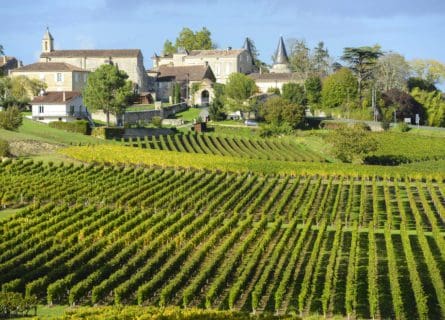
Auxerre Travel Guide
Discover Auxerre: Wine, History, and the Heart of Burgundy
The Yonne departement, roughly midway between Dijon and Paris, has long been the Burgundy wine region’s northern gateway. For visitors, attractions include the verdant countryside, the magical hilltop village of Vezelay, the white wine powerhouse of Chablis, and the alluring Auxerre riverside town. Since Roman times, it has been a port, and even in the 21st century, this delightful town has lost none of its ancient charms. Wandering through the maze of cobbled streets in the old city, you come upon Roman remains, Gothic churches, and timber-framed medieval houses. It is the epitome of a charming, unspoiled French town that’s ripe for leisurely appreciation.
Ancient man first inhabited this corner of France – the first evidence of occupation was found in the Grottes d’Arcy-sur-Cure in ancient paintings. Paleolithic hunter-gatherers and Neolithic tribes were supplanted by Celtic tribes known as the “Icauna,” who were, in turn, absorbed into the Celtic/Gallic culture. They moved into France between 1500 and 500 BC, establishing trading links with the Greeks by about 600 BC, whose colonies included Massilia (Marseille) on the Mediterranean coast.
However, Auxerre’s first recorded history is as a Roman settlement known as Autissiodorum. The settlement was strategically placed on the area’s main roads, the Via Agrippa and the Yonne River. History isn’t exactly sure of when Autissiodorum was founded. Still, we know that by the third century AD, it became the seat of a bishop and the provincial capital of the Roman Empire. The Romans controlled Gaul (France) for centuries – they reveled in their heyday with a riot of splendid public buildings: magnificent baths, temples, and aqueducts of almighty proportions, such as the Pont du Gard near Nimes in southern France. However, continued attacks from Germanic civilizations from Gaul prompted the Romans to fortify Autissiodorum – the Gallo-Roman castrum’s birth (fortified military camp) overlooking the settlement laid down Auxerre’s morphology for good.
In the 5th century, the Alemanni and Franks wrestled control of Gaul from the Romans, who could only watch in horror as their Western Empire collapsed. From the 5th to the 10th centuries, the Frankish Merovingian and Carolingian dynasties ruled over France – Charles Martel’s grandson, Charlemagne, extended the kingdom’s boundaries and was crowned Holy Roman Emperor in 800. But during the 9th century, Scandinavian Vikings (also called Norsemen, thus Normans) raided France’s western coast, settling in the lower Seine valley and forming the Duchy of Normandy a century later. Meanwhile, Auxerre embraced Christianity in the 5th century, culminating in the constructing of a magnificent cathedral. The settlement’s most famous bishop was Saint-Germain (418-448), who introduced the monastery construction movement to Auxerre.
By the Middle Ages, Auxerre had transformed from a small settlement into a thriving town. Its prosperity largely hinged on the transport of wine and timber to Paris – the need to use the Yonne River to transport these goods gave rise to a large mariner community. A new class of Bourgeoisie emerged, building many elegant houses in the center in prominent displays of their newfound wealth. It seemed that Auxerre would forever be at peace with the world.
Of course, it could not last. During the Hundred Years’ War (1337-1453), the French suffered particularly nasty defeats at Crecy and Agincourt. Abbey-studded Mont St-Michel was the only place in northern and western France not to fall into English hands. Auxerre was part of the territory controlled by the dukes of Burgundy and, therefore, allied with the English. Many terrible battles were fought during the Hundred Years’ War, ending in 1453 when the English were driven out of French territory (except for Calais). Formerly a Burgundian town, Auxerre became part of France under the unification of Louis XI. His son, Charles VIII, wed Anne de Bretagne in 1491, marking the unification of independent Brittany with France.
Unfortunately, the unification of France did not bring the lasting peace and prosperity that the citizens of Auxerre desired. The Reformation swept through Europe in the 16th century – the ideas of Jean Calvin strengthened it in France. The tipping point was the Edict of Jan (1562), which afforded Protestants certain rights and caused a massive outcry among Catholics. The Wars of Religion lasted from 1562-98 – the Huguenots took Auxerre in 1567 and embarked on a program of destruction of any building related to the Catholic faith.
Social and economic crises marked the 18th century. France was declared a constitutional monarchy, and reforms were enacted. But as the new government armed itself against the threat posed by Austria, Prussia, and the many exiled French nobles, politics took a decidedly revolutionary turn! In September 1792, France’s first Republic was declared, and Louis XVI was publicly guillotined in January 1793. Auxerre was not significantly affected by this turn of events, although, in the 18th century, the town’s medieval ramparts were torn down. At the same time, the new Republic revoked its status as a cathedral town instead of becoming a prefecture of the Yonne département in 1804.
The subsequent rise to power of Napoleon Bonaparte coincided with a generally prosperous era for the citizens of Auxerre. Although his reign was cut short in 1814 – Napoleon was exiled to Elba, and his subsequent defeat at the battle of Waterloo led to his permanent banishment – Napoleon’s nephew led a coup d’etat in 1851. He proclaimed himself Emperor Napoleon III of the Second Empire. France enjoyed significant economic growth at this time, although, like his uncle, Napoleon III embroiled France in various catastrophic conflicts, including the Crimean War and the humiliating Franco-Prussian War (1870-71).
However, Auxerre flourished in the latter half of the 19th century – several major infrastructure projects were undertaken, including a railway station, a psychiatric hospital, and the courts. New housing developments took place on the right bank of the Yonne. Until the early 20th century, Auxerre was one of the most prosperous cities in the departement, and the flourishing wine industry around the village of Chablis did much for the wider region’s reputation. Chablis was the talk of London, Paris, and beyond.
This prosperity continued into the early 20th century, which saw the emergence of banks, a covered market (subsequently destroyed), and the flourishing of art deco architecture. The town emerged relatively unscathed from the World Wars of the 20th century, although the cost to France was dear. A trip to the Somme or Verdun battlefields goes some way to revealing the unimaginable human loss of WWI. Much of the war occurred in northeastern France, with trench warfare using thousands of soldiers as cannon fodder to gain a few meters of territory.
Auxerre and the rest of France greeted the 21st century with optimism. The town and wider region continue to prosper as a center of wine production and international tourism. However, even in July and August, the tourist crowds in Auxerre are very manageable. This is the town’s fantastic quality – vibrant and tranquil. Climbing to the town’s top, you’ll enjoy views across a jumble of belfries, spires, and steep tiled rooftops leading down to the boats bobbing on the river Yonne.
Meanwhile, the streets below are full of enticing restaurants, cafes, and bars. But best of all, Auxerre makes a beautiful base for exploring northern Burgundy, including the vineyards of Chablis. It’s a terrible cliché but an undeniable fact – there is something for everyone in Auxerre.
-

Beef Bourguignon Gastronomy & Wine
Yonne is a departement that forms part of the Bourgogne-Franche-Comte region, including the majestic vineyards of the Cote d’Or. Many believe that Burgundy is France’s most important gastronomic region after Paris – a temple du gastronomie. The trinity of the Burgundian kitchen is beef, red wine, and mustard. Its most famous and signature dish is undoubtedly Boeuf bourguignon, beef marinated and cooked in young red wine with mushrooms, onions, carrots, and bacon. Served with a bottle of Chambertin, there’s no gastronomic pleasure quite like it. Dijon, the Burgundy capital, has been synonymous with mustard for centuries, and Lyon is renowned for the quality of its cuisine.
Indeed, Burgundy’s signature dishes list reads like the beginner’s guide to French gastronomy. Snails (escargots) are another specialty of the region, typically prepared with delicious garlic and parsley butter, which melts into the shells as the snails cook. Gougeres are another firm favorite with visitors – they are often served as a starter in Auxerre’s restaurants and bistros. They are divine in their simplicity, a cheesy choux pastry ball that can come either as an individual choux or in larger, airy buns torn apart and shared around the table. Oeufs en meurette are also very popular in Auxerre, a delicious concoction of shallots and lardons added to red wine and meat stock soup, topped with a poached egg, and served with crispy baguette.
However, unlike other more famous parts of Burgundy, Yonne is not a region full of Michelin stars and luxurious addresses. Instead, the emphasis is firmly on fresh, seasonal ingredients and traditional recipes – this is not a center of avant-garde, experimental cooking. Yet, it is challenging to eat poorly in Auxerre, unlike some of Europe’s more touristy hotspots.
Auxerre and the wider region are also a paradise for cheese epicures. Burgundy’s most celebrated cheese is undoubtedly Epoisse, a washed-rind cheese of incomparable flavor and aroma. Yet the pungent smells from the skin fool the unaccustomed foodie into expecting a strong, direct hit on the palate. Instead, the taste is far more mellow than expected, with a rich, complex, savory nuttiness and notes of honey and wildflowers. It is truly the prince of cheeses. Aisy Cendré, Charolais, Saint-Florentin, Soumaintrain, and Vézelay are also well worth a look.
But first and foremost, Burgundy is a land of excellent wines, which naturally are omnipresent in the regional cuisine and provide the ideal accompaniment to local dishes. Auxerre’s most prestigious and nearest vineyard is Chablis – the vineyards are located on limestone soil to the southeast of Paris and the north of Burgundy. There are currently around 4600 hectares under vine. The region is subject to a strict hierarchy, with vineyards classified according to the perceived quality of the wine they produce. Chablis comes in four levels: Grand Cru, Premier Cru, Chablis, and Petit Chablis. However, the importance of growing in Chablis is that the Premier Crus from the best estates can easily outperform weaker Grand Cru efforts.
So what defines that unique Chablis character? An elegant, stony mineral character and citrus and apple aromas are typical – above all, it should be ripe, not lean. Some wines are floral, citrusy, or peachy, but there should be an unmistakable mineral aspect and great depth, with a toasty, honeyed complexity with age. They are among the most excellent white wines on earth at their best. Of course, any good restaurant in Auxerre will stock a range of wines from further afield, including some choice examples from the Cote d’Or.
A Guide to the Gastronomy of Burgundy: Read more
Nearby Wine Regions
-
 Discover the magic of Burgundy, where tradition meets innovation. Delve into complex terroirs and the flavors of Pinot Noir and Chardonnay. Plan your trip! Read more
Discover the magic of Burgundy, where tradition meets innovation. Delve into complex terroirs and the flavors of Pinot Noir and Chardonnay. Plan your trip! Read more
Highlights
-
Abbaye St-Germain
The ancient Abbaye St-Germain started life as a basilica above the tomb of St-Germain, the 5th-century bishop who made Auxerre an important Christian center. Over the centuries, as the site’s importance grew, so did the abbey, and by the Middle Ages, it was attracting pilgrims from all over Europe. The key highlight is the Abbey’s crypt, which contains some of Europe’s most excellent examples of Carolingian architecture.
-
Musee d'Art et d'Histoire
Housed around the Abbey St-Germain’s cloister, the Musee d’Art et d’Histoire displays fascinating prehistoric artifacts, Gallo-Roman sculpture, and pottery discovered in and around Auxerre.
-
Cathedrale St-Etienne
This vast Gothic cathedral is undoubtedly one of Europe’s most impressive examples of religious architecture. Its stately 68m-high bell tower dominates Auxerre’s skyline. The choir, ambulatory and some of the vivid stained-glass windows date back to the 1200s. However, the Gothic western front was severely damaged by the hammer-happy Huguenots, who decapitated most of the statues during The Wars of Religion.
-
Chablis
A name synonymous with excellent white wine, the well-to-do but sleepy town of Chablis comes alive in the summer months and is easily accessible from Auxerre for a day trip.
Recommended for you
More information
If you would like us to customize an exclusive luxury tour, contact us and let us know your travel plans. We offer luxury food and wine tours for private groups of a mininium two guests. In addition, all of our private, chauffeured tours are available year-round upon request.














